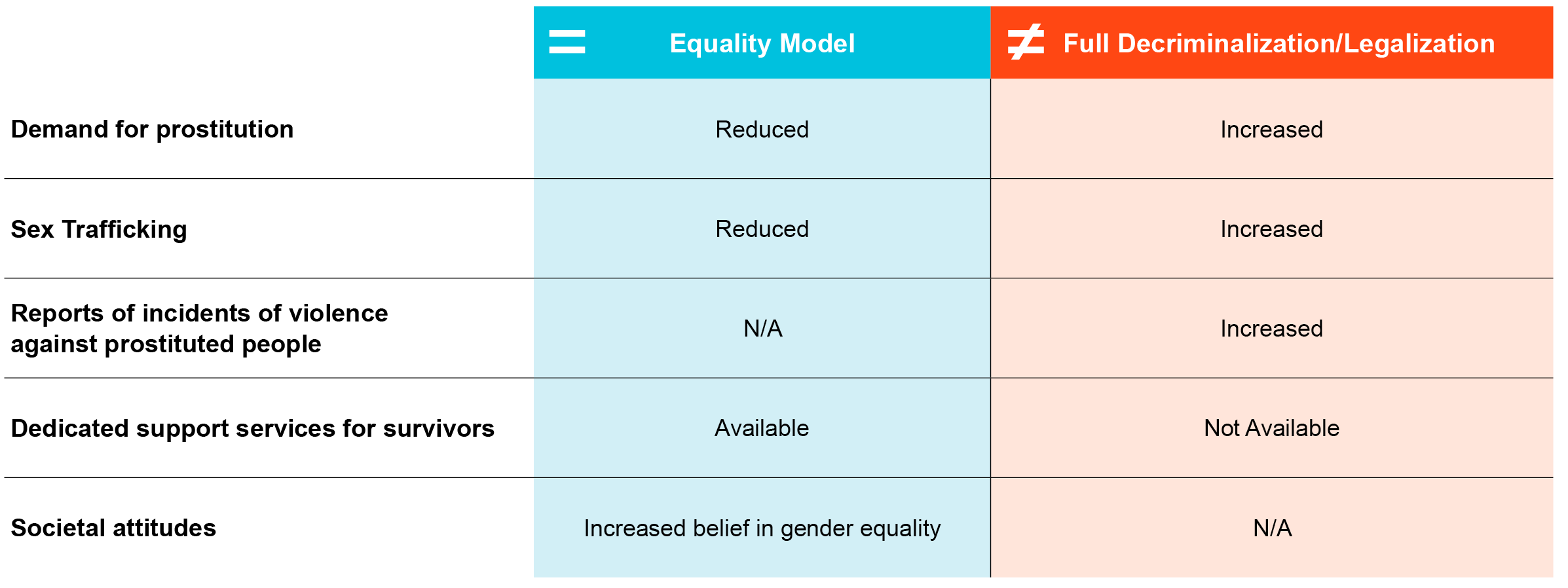What is the
equality model?
And why is its adoption
in the United States so vital?
The Equality Model prioritizes the rights of those who have been exploited while holding buyers and exploiters accountable for the harm they cause.
There is broad consensus in the gender justice and human rights communities – and across the political spectrum – that those who have been prostituted or trafficked should not be criminalized. Beyond this fundamental area of agreement, however, there are two diverging views. On one side are those who argue for full decriminalization or legalization of the entire commercial sex industry, including pimps, brothel owners, and sex buyers (this has been broadly defined as the “sex workers’ rights” position). On the other side are those who argue for social services for, and the decriminalization of, those who are prostituted or trafficked while holding pimps, brothel owners, and johns accountable for the harm that they cause. This is the Equality Model.
The Equality Model was developed by listening to sex trade survivors.
The Equality Model (sometimes also called the Nordic Model or partial decriminalization) originated in Sweden in 1999, as a tool to combat commercial sexual exploitation while promoting gender equality. In the years that have followed, the Equality Model has been adopted by a host of countries that have prioritized human rights and gender justice, including Canada, Ireland, Northern Ireland, Iceland, France, Israel and Norway. Today, there is a growing movement advocating for its adoption by the United States.
The Equality Model was developed by listening to survivors of the sex trade, who are the ultimate authorities on their own experiences. At the heart of this model is their belief that treating prostituted or trafficked persons as victims of a crime, and not criminals themselves, is a critical first step in the fight for an exploitation-free world. But we can’t stop there. Advocates for the Equality Model believe that the provision of much-needed social services and an embrace of policies that promote economic justice are necessary in order to help those who seek to exit the sex trade stay out of the sex trade.
The Equality Model has been proven to reduce the number of people who are victims of human trafficking and sexual exploitation.
In the countries that have implemented the Equality Model over the course of several years, the results are clear. Take Sweden, where the Equality Model was implemented in 1999. That country saw a 50% decrease in street prostitution and a significant decline in the number of men purchasing sex within two years after the law was implemented. Norway found that within five years after it adopted the Equality Model, street prostitution declined between 30-60%, and indoor prostitution declined between 10-20%.
What happens when pimping, brothel owning or sex buying is decriminalized, or legalized?
Full decriminalization or legalization increases the demand for prostituted persons, causing the overall sex trade to grow.
In countries that have embraced full decriminalization or legalization, the demand for prostituted persons has increased, leading to an expanded sex trade and a boom in sex tourism. A case in point is Germany, which legalized sex buying in 2002. Today, an estimated one million German men purchase sex every day in Germany. Berlin, the nation’s capital, has over 500 brothels and 150,000 people in prostitution.
In countries where the sex trade is fully decriminalized or legalized, human trafficking inflows from other regions increase.
It’s Economics 101: Supply grows to meet demand. And for prostituted or trafficked persons, the consequences of that demand can be devastating. In a groundbreaking 2012 study, “Does Legalized Prostitution Increase Human Trafficking,” researchers at the German Institute for Economic Research, Heidelberg University and the London School of Economics analyzed data from 116 countries to answer that question. Their conclusion? Countries that have embraced legalization have higher inflows of human trafficking than countries where sex buying is prohibited. Demand for persons exploited in their country of origin increases as well.
A decriminalized sex trade is not a safer sex trade.
One of the primary arguments made by those who advocate for legalized pimping, brothel owning, and sex buying is that a legal sex trade is a regulated, and thus a safer, sex trade. Setting aside the fact that market regulation varies based on region and political will, evidence does not support this. In fact, a 2008 study by a multidisciplinary committee formed by the government of New Zealand – a country that legalized prostitution in 2003 – shows that rates of violence did not decrease when the sex trade was legalized, nor did prostituted persons report feeling safer or being more likely to report to authorities violence they experienced in the sex trade.
To legalize the sex trade is to normalize the sex trade, increasing overall social acceptance of the buying and selling of human beings.
One of the most devastating consequences of the legalization or full decriminalization of the sex trade is also one of the most subtle. When we treat the buying or selling of other human beings as a victimless crime, or not a crime at all, we normalize it. Such normalization impacts the way men see vulnerable persons – particularly vulnerable women and girls of color. It also impacts the way that those who are bought, sold, or exploited see themselves.
By contrast, the Equality Model is grounded in the belief that the sex trade does long-term damage to the body, mind, and spirit of those who are exploited in it. These are harms that cannot be regulated away. A just and equitable society should not view the buying of another human being as inevitable, acceptable, or normal. This is why the adoption of the Equality Model in the United States is so critical.


